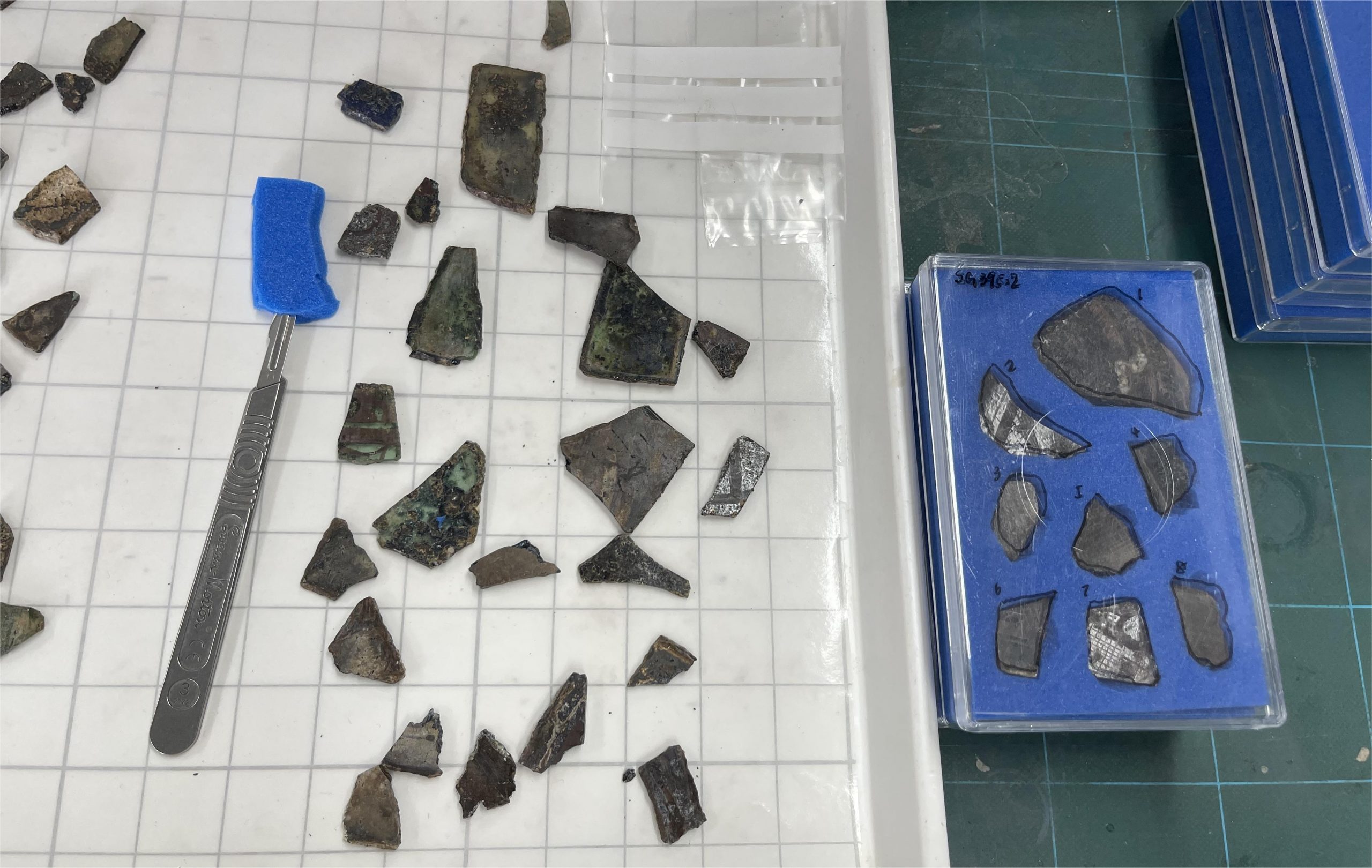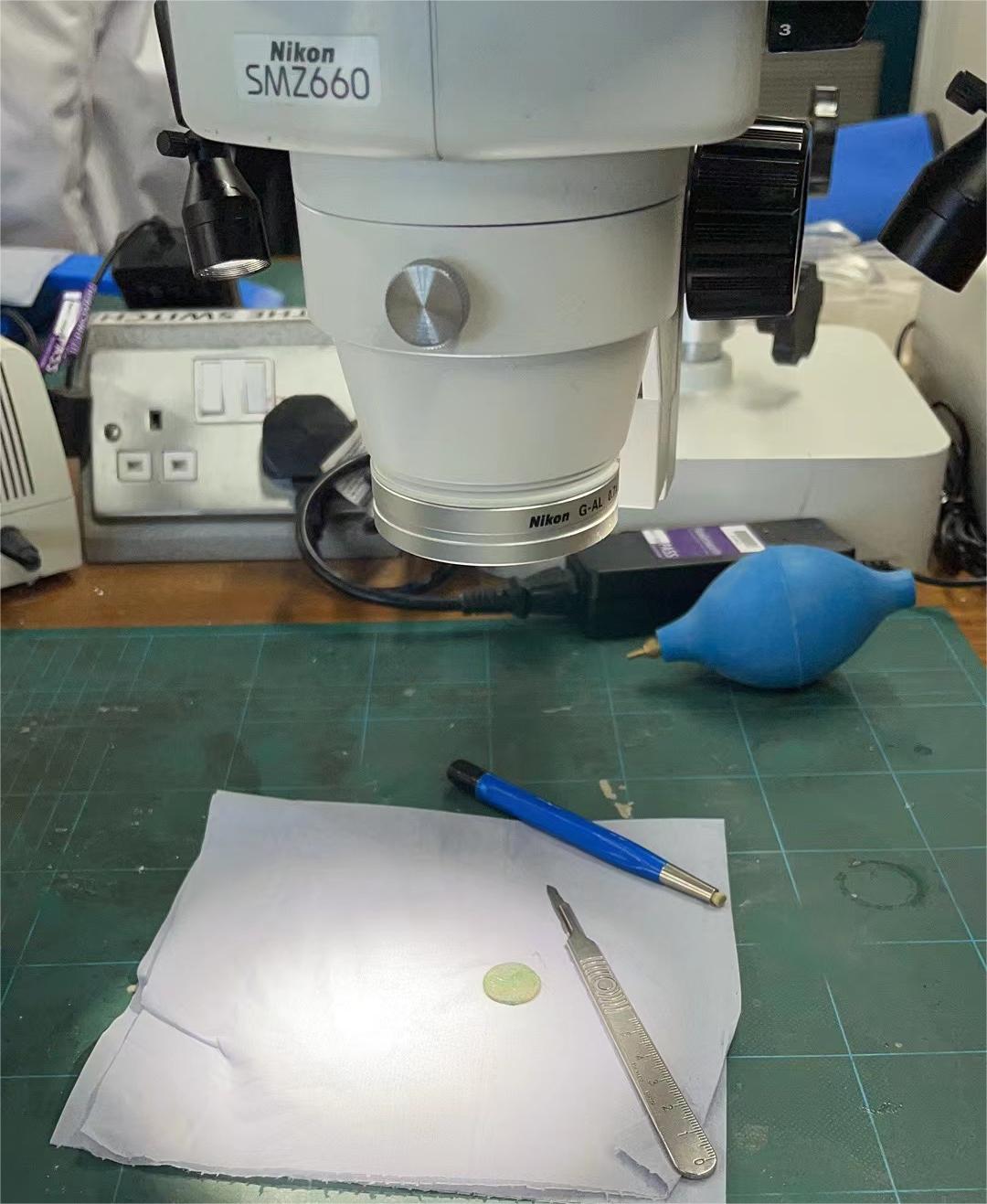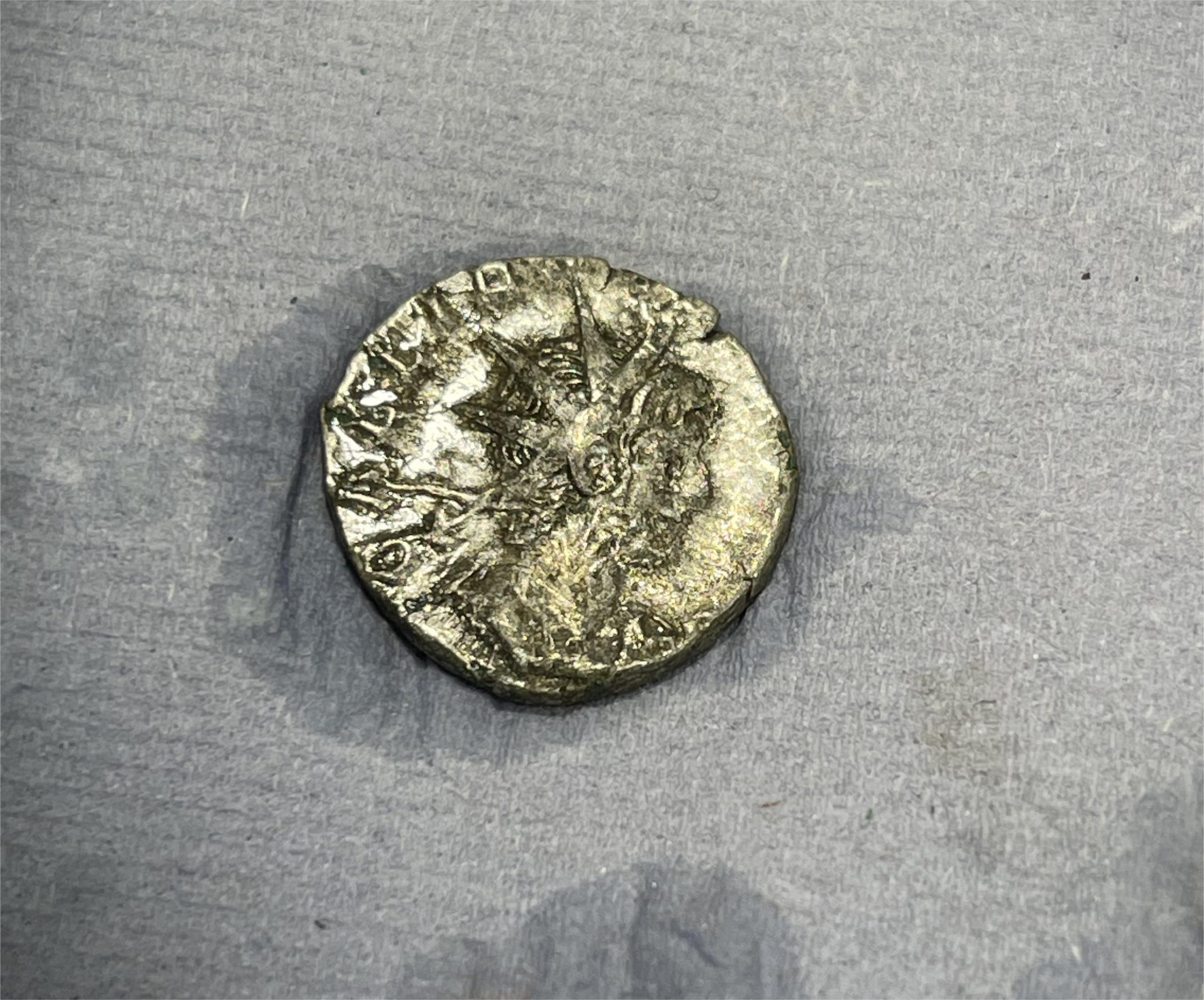My Summer Placement Experience
29 January 2023
My summer placement is 4 weeks with Phil and my classmates in the Cardiff University conservation lab. I learned many skills and completed several works, which gave me a strong sense of achievement.
In the first week, we got a big amount of medieval glasses from the Dominican Blackfriary, which was excavated and stored in boxes with soil. Most of them are dark colour with dark red painted pattern. We also have some dark blue, green and red glass (Figure1).
There are different degrees of corrosion on these glasses, their surface built up alkaline corrosion products and some pitting corrosion, which make them very fragile. First, we dug them out of the soil and cleaned them gently with water and brush. We placed them in trays and left them to dry. Then we used 10% Paraloid B72 in acetone painted the surface with small brush for consolidation (Figure2). For some broken parts I glued them together with 20% Paraloid B72 in acetone. After that we took photographs for record them.


For the storage, we used the crystal box (Figure3) and two plastazote pieces to pack them. We cut the plastazote to match the size of the box and then used scalpel to cut out the same shape as the glass on the top layer. Try to place the same style of glass together and place the painted side up. In this way, glasses would be held by the plastazote and people can clearly view them from outside.

We learnt how to clean Roman coins. These coins dating from the third century, were excavated in Montgomery field. They may have been associated with Roman life in mid-Wales in the late 3rd century AD. These coins are of copper-silver alloy and the usual methods of removing corrosion products are mechanical, chemical and electrochemical (Costa, 2001)

We put the coins into Rochelle salt for about 10 minutes to remove the copper minerals. Rochelle salt is prepared with 5% sodium hydroxide,15% Potassium sodium tartrate in deionised water. Then used scalpel to help clean the rest of corrosion products.
Each of us was given a special object from Repton. Mine is a very fine silver hook. Actually, it could be a silver Anglo-Saxon dress hook . This kind of hooks were found in Anglo-Saxon tombs and probably dating from 650-700 AD. This form of decoration popularity in the 16th century again. They are usually cast, with openwork and relief decoration (Flynn and Geake, 2016).The feature of this object is more similar to the post-medieval hook (Figure7).Its body is circular, looks like a lizard or snake, coiled together, with spots and patterns on its body, and its tail curled into a connecting loop.


Firstly, I used IMS and cotton swabs to remove the dirt and dust from its surface. Under the microscope, more detail was revealed and I was surprised to find a small yellow ball set in one of its eyes (Figure8). I wasn’t sure what it was made of, guessed it might be some kind of stone or amber. To confirm its material, we did XRF test, X-ray fluorescence can determine the elemental composition of the sample and does not destroy it. The results of the eye showed a high proportion of silicon and oxygen. This can prove that it is a type of stone or glass, but not amber. Because amber is composed mainly of carbon, oxygen and hydrogen.


XRF also showed the main elements of the hook are gold and silver, so it could be a silver gild hook. For the broken parts, I chose to use 20% Paraloid B72 in acetone as the adhesive, because it is flexible, reversible and easy to apply. However, it was too thin and light, so I used a small piece of Japanese paper stick to the back of conjunction (Figure9). This gives more adhesion at the joint. It is a good method for gluing light and thin materials.

The plaster cast of Djedhor’s statue base is the largest object we have treated in this placement. It is from the Egyptian Centre and its original is the black-basalt statue of the priest Djedhor from Cairo Museum. The text covered on its surface is an Egyptian incantation for the healing of animal bites such as scorpions and snakes (Attalus, 2020).

As you can see in the picture (Figure10), the main problem is the colour has rubbed off the surface, exposing white plaster. We need to repaint the white areas and fill plaster in the small pits in the surface to make them seem like the original. We worked on different side, it is a wonderful team work. I mixed acrylic colours and water and tried them on plaster which gave me the feel of being a painter.I worked on the front side. For the two larger scratches, I painted darker colour and then blended some creamy white to create a straight line to connect up and down. This visual deception makes it is hard to notice the dent area. I am very happy to see that the statue back to The Egyptian Centre and reunited with statue of Djedhor the Saviour. More information can be seen in the blog of the Egyptian Centre.

References
3,000 Roman 3rd Century Coins Found in Montgomery Field. (2011). BBC News. [online] 27 Jul. Available at: https://www.bbc.co.uk/news/uk-wales-mid-wales-14307381 [Accessed 27 Jan. 2023].
Attalus (2020). Egyptian Texts : Djhedhor, a Healer-Priest. [online] www.attalus.org. Available at: http://www.attalus.org/egypt/djedhor.html [Accessed 27 Jan. 2023].
Costa, V. (2001). The Deterioration of Silver Alloys and Some Aspects of Their Conservation. Studies in Conservation, 46(sup1), pp.18–34. doi:10.1179/sic.2001.46.supplement-1.18.
Flynn, T. and Geake, H. (2016). Hooked Tags and Other Dress Hooks and Eyes. [online] Finds Recording Guides. Available at: https://finds.org.uk/counties/findsrecordingguides/hooked-tags-and-other-dress-hooks/#Hooks [Accessed 27 Jan. 2023].
Griffin, K. (2022). Egypt Centre Collection Blog: Reuniting the Statue of Djedhor the Saviour. [online] Egypt Centre Collection Blog. Available at: https://egyptcentrecollectionblog.blogspot.com/2022/12/reuniting-statue-of-djedhor-saviour.html [Accessed 27 Jan. 2023].
- March 2024 (1)
- December 2023 (1)
- November 2023 (2)
- March 2023 (2)
- January 2023 (6)
- November 2022 (1)
- October 2022 (1)
- June 2022 (6)
- January 2022 (8)
- March 2021 (2)
- January 2021 (3)
- June 2020 (1)
- May 2020 (1)
- April 2020 (1)
- March 2020 (4)
- February 2020 (3)
- January 2020 (5)
- November 2019 (1)
- October 2019 (1)
- June 2019 (1)
- April 2019 (2)
- March 2019 (1)
- January 2019 (1)
- August 2018 (2)
- July 2018 (5)
- June 2018 (2)
- May 2018 (3)
- March 2018 (1)
- February 2018 (3)
- January 2018 (1)
- December 2017 (1)
- October 2017 (4)
- September 2017 (1)
- August 2017 (2)
- July 2017 (1)
- June 2017 (3)
- May 2017 (1)
- March 2017 (2)
- February 2017 (1)
- January 2017 (5)
- December 2016 (2)
- November 2016 (2)
- June 2016 (1)
- March 2016 (1)
- December 2015 (1)
- July 2014 (1)
- February 2014 (1)
- January 2014 (4)